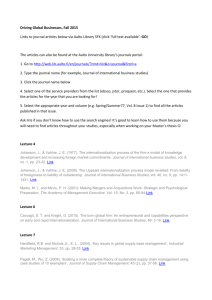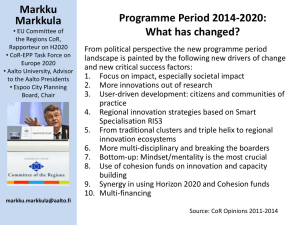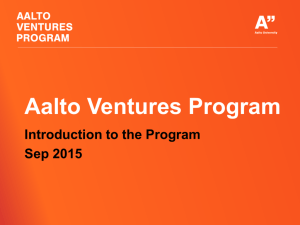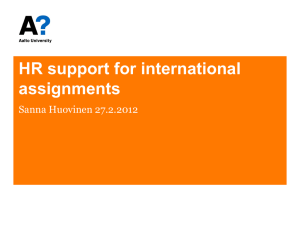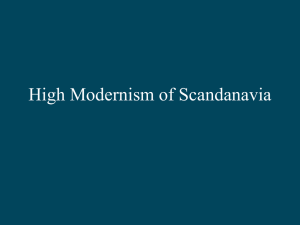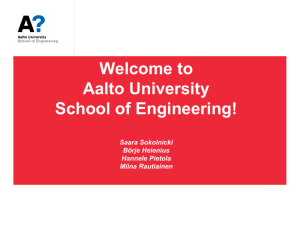S POTLIGHT Business Schools
advertisement
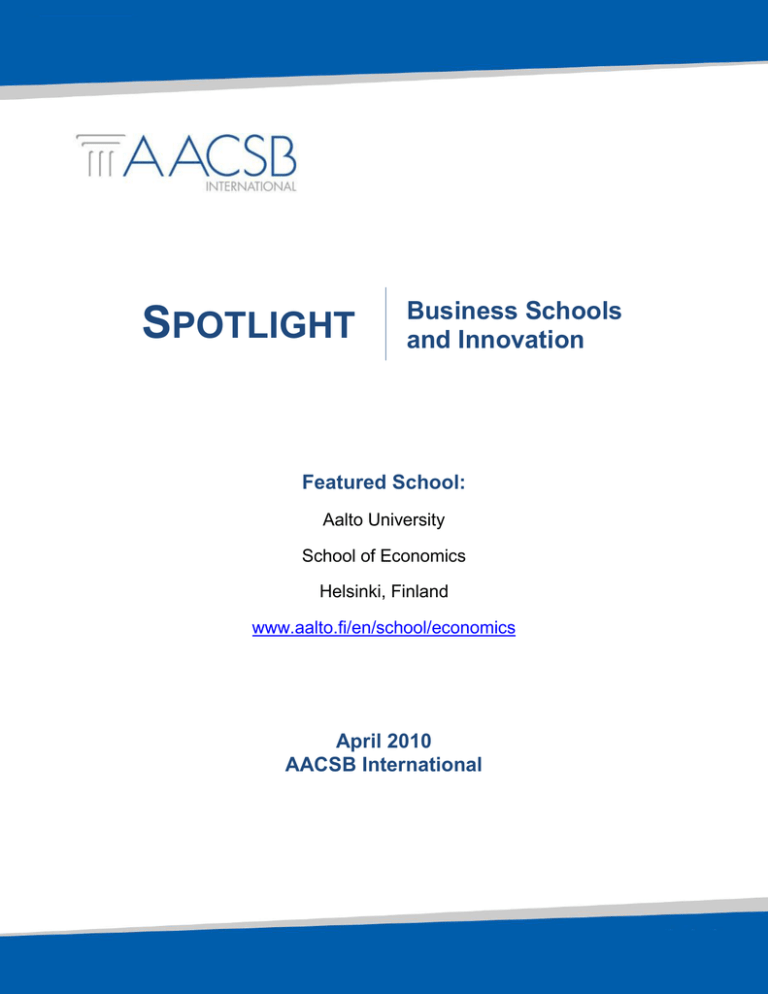
SPOTLIGHT Business Schools and Innovation Featured School: Aalto University School of Economics Helsinki, Finland www.aalto.fi/en/school/economics April 2010 AACSB International Aalto University School of Economics The Helsinki School of Economics (HSE) joined University of Art and Design Helsinki, and Helsinki University of Technology, to become part of Aalto University as of January 1, 2010. The three now operate under their new names: Aalto University School of Economics, Aalto University School of Art and Design, and Aalto University School of Science and Technology. The merger was intended to create a business-focused institution that is multi-disciplinary in every aspect and capitalizes on Finland’s reputation for industrial and product design. Indeed, according to Eero Kasanen, Dean of the School of Economics, the original project name for the new university was Innovation University, prior to settling on the Aalto name. Dean Kasanen notes three major societal trends that ultimately led to the merger of the three schools. First, both the Finnish government and the private sector felt the need for greater innovation to keep the economy competitive in the globalizing world. Second, as part of the government’s drive to increase public sector efficiency, university reform was needed to cut public spending, particularly in light of the fact that Finland has one of the highest numbers of universities per capita of any country in the world. Finally, it was felt, particularly in the private sector, that the underfunding of so many public universities was a threat to their quality. Part of the mission of the Aalto School of Economics, which has not changed from its former HSE incarnation, calls for the school to “[seek] to create innovative business expertise that improves competitiveness for those in positions of leadership today and tomorrow, for companies, and for society at 1 large .” The merger has served to bring the School of Economics closer together with the other schools in the pursuit of this mission – a shift particularly felt by the student body which, Kasanen notes, is highly active in university governance. The student union has taken a particular interest in aiding the faculty in 2 the planning of interdisciplinary degree programs , such as new Master’s degrees in Creative Sustainability and International Design Business Management (IDBM), which is coordinated through the School of Economics. 3 The IDBM Master’s degree is a cross-disciplinary Master’s degree program that developed out of a minor program of the same name, which had been conducted for the past 15 years in cooperation between the three pre-merger universities. Each school contributed one third of each year’s cohort, and the students worked in interdisciplinary teams to earn the minor while majoring in their own fields. The new Master’s in IDBM will continue this aspect of its predecessor, while developing common ground for all participating students. Each year, 10-15 students in the final phase of the program are invited to participate in an IDBM Project for Finnish firms. The selected students form interdisciplinary teams of 3-5 students, and are joined by a project manager and expert from the university (“tutors”) who oversee the project’s completion and assist with planning and scheduling. Participating companies contribute approximately €10.000 + VAT towards program support, and receive the student team’s solution to a project ranging in scope from new product concepts (design and user interface issues), the definition of customer needs and the future environment of a product, the analysis of markets and customer feedback, and the examination of corporate identity, communications and design management, among other things. Other projects on which the three pre-merger universities already have a history of working together include product development, media, and value-added services development. The new university has taken these collaborations to the next level by inaugurating the Aalto University Service Factory, Media 4 Factory, and Design Factory. The Factories are designed to be platforms for multi-disciplinary collaboration, combining the expertise of the three Aalto University schools in the fields of service innovation, management, and design; media and communication; and product development, respectively. They facilitate a collaborative environment between academic teams, researchers, students, firms, and other members of the community. Though the development of these interdisciplinary programs is key to creating and supporting innovation, says Dean Kasanen, the idea is not to force the three schools to become totally integrated, but simply to offer plentiful opportunities for cross-disciplinary exposure and the development of useful skills for students who are desirous of a more rounded educational experience. “Ideally graduates from business programs have as much knowledge as possible in their own fields of business and have combined that education with interesting modules in other fields. The goal is to create value through a deep knowledge of one’s own field and some knowledge in other fields,” he says. Though there is no expectation that all Aalto students will pursue extensively multidisciplinary study, the availability of these programs is intended to be a major asset to the development of graduates who are prepared to operate as innovative, boundary-spanning managers. In addition to degree-based education in support of innovation, the faculty members of the Aalto University School of Economics also are active in consulting and industry research. Aiming both at scientific contribution and practical relevance, one of the four main areas of research activity at the school is in Business Networks, which focuses on innovation and development networks, strategic 5 business net development, and the network economy and its emergence in new business fields . These research projects are undertaken by experts representing several disciplines within the School of Economics. Finnish culture and current economic policy work in tandem to promote innovation and technological development, says Dean Kasanen, through government funding for university research, as well as for private sector-university partnerships. The Finnish Ministry of Education supports a Research and 6 Innovation Council (formerly called the Science and Technology Policy Council) , which exists in part to address the development and allocation of public research and innovation funding. The European Union likewise funds multi-university and company-sponsored research. Kasanen notes that Aalto University benefits greatly from its network of public and private sector sponsors, which it uses to help develop the capacity for business incubation and venture capitalism from within the university itself. The new school is in the process of determining how best to integrate the incubation and entrepreneurship centers that existed at each of the three pre-merger universities. Dean Kasanen says that Aalto University also has a plan to increase its endowment to €1 billion. €500 million are expected to come from government sources, €200 million are expected to come from private sponsors, and €300 million has been generated by transferring real estate from the state ownership to the 7 university. The school now has a dedicated innovation services manager who is responsible for evaluating ideas and their commercial potential, advising on questions and contractual matters of intellectual property rights and the commercialization of ideas, and, if necessary, providing instruction on the subject for both students and staff. The manager has a background in the venture capital industry, according to Kasanen, and is responsible for establishing and maintaining relations between the university, its researchers, and private sector businesses. Aalto University’s very existence is testament to the understanding that innovation is both a challenge and an opportunity, and that creating the environment in which innovation can arise necessarily involves multidisciplinarity. “We don’t have all the answers,” says Kasanen, “but we are starting to understand the questions.” Acknowledgements: AACSB International is grateful for the assistance of Eero Kasanen, Dean of the Aalto University School of Economics. End Notes 1 Aalto University. School of Economics. (2010) HSE Strategy. Electronic document, http://www.hse.fi/EN/abouthse/introduction/mission/, accessed February 25, 2010. 2 Aalto University. (2010) Cross-Disciplinary Studies in Aalto University. Electronic document, http://www.aalto.fi/en/studies/mobility/crossdisciplinarity/, accessed April 13, 2010. 3 Aalto University. (2010) IDBM Master’s Program in Brief. Electronic document, http://project.hkkk.fi/idbm/, accessed February 25, 2010. 4 Aalto University. (2010) Factories. Electronic document, http://www.aalto.fi/en/studies/mobility/factories/, accessed April 13, 2010. 5 Aalto University, School of Economics. (2010) Business Networks Research. Electronic document, http://www.hse.fi/EN/research/programs/bn/introduction/introduction.htm, accessed February 25, 2010. 6 Ministry of Education of Finland. (2010) Research and Innovation Council. Electronic document, http://www.minedu.fi/OPM/Tiede/tutkimus-_ja_innovaationeuvosto/?lang=en, accessed April 12, 2010. 7 Aalto University, School of Economics. (2010) Innovation Services. Electronic document, http://www.hse.fi/EN/units/admin/innovation/innovation.htm, accessed April 5, 2010.
